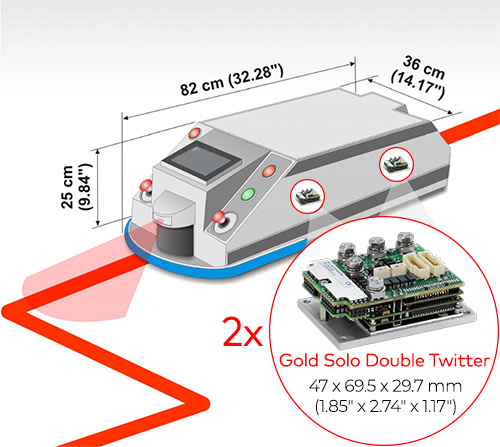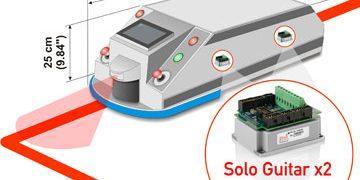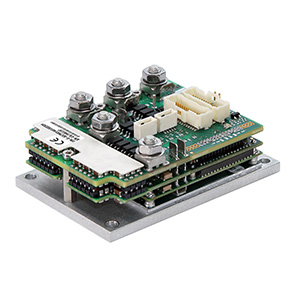A leading mobile robot manufacturer wanted to develop a portable, heavy-duty, two-wheeled, autonomous vehicle that could follow magnetic tape to move and transfer heavy components in manufacturing plants.
Read this case study to learn about:
- Implementing up to 10 kW of peak power using a tiny servo drive.
- Placing servo drives in a confined space where size is a critical design consideration.
- Using servo drives that can withstand demanding factory conditions and are compatible with both brush and brushless motors.
- Minimizing development time and reducing the number of system components to achieve a short time-to-market.
Machine Requirements
The manufacturer aimed to build the smallest, most cost-effective mobile robot that could handle loads of up to one ton (2,000+ lb). All components used in the robot had to be able to withstand an industrial environment and perform reliably with off-the-shelf components, for quick time-to-market.
The motion control products had to supply high power density within a small unit that could fit easily into the robot. The robot had to be highly reliable, with an extended Mean Time Between Failures (MTBF) for all its different motion functions.
As the robot incorporated an adaptive, line-sensing technique, the motion commands had to be delivered and received swiftly and accurately to provide precise motion in challenging and delicate operations.
Battery drainage was also a key concern as having too many oversized components would mean having to recharge batteries multiple times within a shift. Eliminating components would reduce overall costs, especially in the long-term.

Motion Control Solution
- 2 Gold Solo Double Twitter servo drives
The team selected the Gold Solo Double Twitter, part of Elmo’s Gold Line, which is designed for applications that require compact size, integrated intelligence and high-power density efficiency. Gold Solo Double Twitter drives can reliably meet the strenuous demands of 24×7 manufacturing environments, including high ambient temperatures. In this application, two Gold Solo Double Twitter drives were installed within the vehicle, close to the motors. The connector types and locations were chosen to optimize the robot’s production and minimize maintenance. Elmo’s application engineers worked with the design team to ensure a successful integration and to reduce time-to-market.
With Elmo’s advanced, unipolar switching technology, servo drives can run motors efficiently without wasting current on conventional control. This is achieved by reducing between-shift inefficiency and increasing production utilization by running the motors efficiently.
The Gold Solo Double Twitter drives can perform sophisticated motion control loops for precise movement, feedback inputs, programming capabilities and communication support. Elmo’s proprietary EASII (Elmo Application Studio) software is used to program the commands for the servo drives, and this enables the robot to perform precise tasks requiring rapid and accurate movement.
Results
The Gold Solo Double Twitter servo drives met the robot’s requirements, enabling the customer to implement cost-effective, reliable automation in a production line and thus save time and energy. Using off-the-shelf, ready-to-use motion control solutions increased the machine’s efficiency and helped the customer build a highly competitive product.
Gold Solo Double Twitter
Ultra Small Servo drive
160A/80VDC, 140A/100VDC, 40A/200VDC


